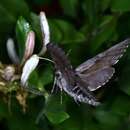en
names in breadcrumbs


Sphinx pinastri, the pine hawk-moth, is a moth of the family Sphingidae. It is found in Palearctic realm and sometimes the Nearctic realm. This species has been found in Scotland but is usually found in England.[2] The species was first described by Carl Linnaeus in his 1758 10th edition of Systema Naturae.
The larvae feed on Scots pine, Swiss pine, Siberian pine and Norway spruce.
The wings of Sphinx pinastri are grey with black dashes. The wingspan is 2+3⁄4–3+1⁄2 inches (70–89 mm).[3] The moth flies from April to August depending on the location.
The back of the thorax is grey with two dark bands around both sides.[4]
The females lay their eggs in groups of two or three along pine or spruce needles.[3]
Sphinx pinastri, the pine hawk-moth, is a moth of the family Sphingidae. It is found in Palearctic realm and sometimes the Nearctic realm. This species has been found in Scotland but is usually found in England. The species was first described by Carl Linnaeus in his 1758 10th edition of Systema Naturae.
The larvae feed on Scots pine, Swiss pine, Siberian pine and Norway spruce.